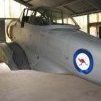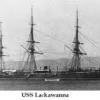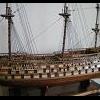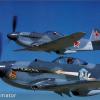MORE HANDBOOKS ARE ON THEIR WAY! We will let you know when they get here.
×
-
Posts
1,197 -
Joined
-
Last visited
Reputation Activity
-
 Stuntflyer got a reaction from PeteB in HM Cutter Cheerful 1806 by Stuntflyer (Mike) - FINISHED - 1:48 scale
Stuntflyer got a reaction from PeteB in HM Cutter Cheerful 1806 by Stuntflyer (Mike) - FINISHED - 1:48 scale
Just a small update. .
After applying a coat of W-O-P to the deck I decided that it was a good time to attach the windlass. The most important thing was to get the windlass centered and parallel to the other deck structures like the coaming directly behind it. Varying plank widths at the bow meant that I couldn't use those joints as an additional guide for alignment. With this in mind and not trusting my eye, I decided to make a jig. The jig was made from a stick ripped to the width of the distance from the coaming to the back of the windlass. Vertical pieces were then glued to the stick for the windlass to back up to. After heat bending the jig was I taped it down to the deck against the forward edge of the coaming. Aligning the windlass was a simple matter of centering it and backing it up to the jig while holding it down for a few minutes until the glue set.
Still need to clean up some of the dust remaining inside th ports.
-
 Stuntflyer got a reaction from tasmanian in HM Cutter Cheerful 1806 by Stuntflyer (Mike) - FINISHED - 1:48 scale
Stuntflyer got a reaction from tasmanian in HM Cutter Cheerful 1806 by Stuntflyer (Mike) - FINISHED - 1:48 scale
Just a small update. .
After applying a coat of W-O-P to the deck I decided that it was a good time to attach the windlass. The most important thing was to get the windlass centered and parallel to the other deck structures like the coaming directly behind it. Varying plank widths at the bow meant that I couldn't use those joints as an additional guide for alignment. With this in mind and not trusting my eye, I decided to make a jig. The jig was made from a stick ripped to the width of the distance from the coaming to the back of the windlass. Vertical pieces were then glued to the stick for the windlass to back up to. After heat bending the jig was I taped it down to the deck against the forward edge of the coaming. Aligning the windlass was a simple matter of centering it and backing it up to the jig while holding it down for a few minutes until the glue set.
Still need to clean up some of the dust remaining inside th ports.
-
 Stuntflyer got a reaction from Canute in HM Cutter Cheerful 1806 by Stuntflyer (Mike) - FINISHED - 1:48 scale
Stuntflyer got a reaction from Canute in HM Cutter Cheerful 1806 by Stuntflyer (Mike) - FINISHED - 1:48 scale
Thanks guys! It feels good to be able to work on the ship without all the saw dust.
druxey, I don't think that pinning the windlass is needed here.
Mike
-
 Stuntflyer got a reaction from GuntherMT in HM Cutter Cheerful 1806 by Stuntflyer (Mike) - FINISHED - 1:48 scale
Stuntflyer got a reaction from GuntherMT in HM Cutter Cheerful 1806 by Stuntflyer (Mike) - FINISHED - 1:48 scale
Just a small update. .
After applying a coat of W-O-P to the deck I decided that it was a good time to attach the windlass. The most important thing was to get the windlass centered and parallel to the other deck structures like the coaming directly behind it. Varying plank widths at the bow meant that I couldn't use those joints as an additional guide for alignment. With this in mind and not trusting my eye, I decided to make a jig. The jig was made from a stick ripped to the width of the distance from the coaming to the back of the windlass. Vertical pieces were then glued to the stick for the windlass to back up to. After heat bending the jig was I taped it down to the deck against the forward edge of the coaming. Aligning the windlass was a simple matter of centering it and backing it up to the jig while holding it down for a few minutes until the glue set.
Still need to clean up some of the dust remaining inside th ports.
-
 Stuntflyer got a reaction from tadheus in HM Cutter Cheerful 1806 by Stuntflyer (Mike) - FINISHED - 1:48 scale
Stuntflyer got a reaction from tadheus in HM Cutter Cheerful 1806 by Stuntflyer (Mike) - FINISHED - 1:48 scale
Just a small update. .
After applying a coat of W-O-P to the deck I decided that it was a good time to attach the windlass. The most important thing was to get the windlass centered and parallel to the other deck structures like the coaming directly behind it. Varying plank widths at the bow meant that I couldn't use those joints as an additional guide for alignment. With this in mind and not trusting my eye, I decided to make a jig. The jig was made from a stick ripped to the width of the distance from the coaming to the back of the windlass. Vertical pieces were then glued to the stick for the windlass to back up to. After heat bending the jig was I taped it down to the deck against the forward edge of the coaming. Aligning the windlass was a simple matter of centering it and backing it up to the jig while holding it down for a few minutes until the glue set.
Still need to clean up some of the dust remaining inside th ports.
-
 Stuntflyer reacted to KenW in Rattlesnake by KenW - FINISHED - Model Shipways - Scale 1:64 - American Privateer
Stuntflyer reacted to KenW in Rattlesnake by KenW - FINISHED - Model Shipways - Scale 1:64 - American Privateer
I finally finished with the Iroquois figurehead. I knew that I wouldn’t be able to carve it, but luckily I have a good friend who is a war gamer. He told me about a site that sold Native American figures that can be included as part of a revolutionary army. I bought twenty figures, and was very impressed with the sculptor. The problem was that all the ‘indians’ were holding a rifle, which I didn’t want on the model. Since the dye cast metal is soft, I cut away the rifle as best I could from the figure I chose. But, that left the left hand unusable. So I took a left hand from another figure, cut off the bad hand and glued the new left hand (which was holding a hatchet) onto the ‘stump’. I also replaced the head because the head feathers were too high. The result looked good. I then painted the figure the same way my friend paints his armies: paint the figure black and when it's dry, add a white dry brush. Next apply several coats of a yellow wash, followed by a black wash made of acrylic floor wax, water and calligraphy ink. The figurehead is not glued to the model yet since I have to make sure the hatchet doesn’t interfere with the bob stay. Over all, I think it looks just fine. I only hope my explanation makes sense.
-
 Stuntflyer got a reaction from tlevine in HM Cutter Cheerful 1806 by Stuntflyer (Mike) - FINISHED - 1:48 scale
Stuntflyer got a reaction from tlevine in HM Cutter Cheerful 1806 by Stuntflyer (Mike) - FINISHED - 1:48 scale
Just a small update. .
After applying a coat of W-O-P to the deck I decided that it was a good time to attach the windlass. The most important thing was to get the windlass centered and parallel to the other deck structures like the coaming directly behind it. Varying plank widths at the bow meant that I couldn't use those joints as an additional guide for alignment. With this in mind and not trusting my eye, I decided to make a jig. The jig was made from a stick ripped to the width of the distance from the coaming to the back of the windlass. Vertical pieces were then glued to the stick for the windlass to back up to. After heat bending the jig was I taped it down to the deck against the forward edge of the coaming. Aligning the windlass was a simple matter of centering it and backing it up to the jig while holding it down for a few minutes until the glue set.
Still need to clean up some of the dust remaining inside th ports.
-
 Stuntflyer reacted to druxey in HM Cutter Cheerful 1806 by Stuntflyer (Mike) - FINISHED - 1:48 scale
Stuntflyer reacted to druxey in HM Cutter Cheerful 1806 by Stuntflyer (Mike) - FINISHED - 1:48 scale
Looking lovely, Mike. Are you planning to pin the windlass to the deck as well?
-
 Stuntflyer reacted to jwvolz in HM Cutter Cheerful 1806 by Stuntflyer (Mike) - FINISHED - 1:48 scale
Stuntflyer reacted to jwvolz in HM Cutter Cheerful 1806 by Stuntflyer (Mike) - FINISHED - 1:48 scale
That's looking absolutely fantastic Mike.
-
 Stuntflyer reacted to Erik W in HM Cutter Cheerful 1806 by Stuntflyer (Mike) - FINISHED - 1:48 scale
Stuntflyer reacted to Erik W in HM Cutter Cheerful 1806 by Stuntflyer (Mike) - FINISHED - 1:48 scale
Mike,
Now that you've finished sanding the deck, and applied a coat of WOP, your worries about any gaps between deck planking are definitely unfounded. Everything looks very tight and clean!
Erik
-
 Stuntflyer got a reaction from Mike Y in HM Cutter Cheerful 1806 by Stuntflyer (Mike) - FINISHED - 1:48 scale
Stuntflyer got a reaction from Mike Y in HM Cutter Cheerful 1806 by Stuntflyer (Mike) - FINISHED - 1:48 scale
Just a small update. .
After applying a coat of W-O-P to the deck I decided that it was a good time to attach the windlass. The most important thing was to get the windlass centered and parallel to the other deck structures like the coaming directly behind it. Varying plank widths at the bow meant that I couldn't use those joints as an additional guide for alignment. With this in mind and not trusting my eye, I decided to make a jig. The jig was made from a stick ripped to the width of the distance from the coaming to the back of the windlass. Vertical pieces were then glued to the stick for the windlass to back up to. After heat bending the jig was I taped it down to the deck against the forward edge of the coaming. Aligning the windlass was a simple matter of centering it and backing it up to the jig while holding it down for a few minutes until the glue set.
Still need to clean up some of the dust remaining inside th ports.
-
 Stuntflyer got a reaction from Ryland Craze in HM Cutter Cheerful 1806 by Stuntflyer (Mike) - FINISHED - 1:48 scale
Stuntflyer got a reaction from Ryland Craze in HM Cutter Cheerful 1806 by Stuntflyer (Mike) - FINISHED - 1:48 scale
Just a small update. .
After applying a coat of W-O-P to the deck I decided that it was a good time to attach the windlass. The most important thing was to get the windlass centered and parallel to the other deck structures like the coaming directly behind it. Varying plank widths at the bow meant that I couldn't use those joints as an additional guide for alignment. With this in mind and not trusting my eye, I decided to make a jig. The jig was made from a stick ripped to the width of the distance from the coaming to the back of the windlass. Vertical pieces were then glued to the stick for the windlass to back up to. After heat bending the jig was I taped it down to the deck against the forward edge of the coaming. Aligning the windlass was a simple matter of centering it and backing it up to the jig while holding it down for a few minutes until the glue set.
Still need to clean up some of the dust remaining inside th ports.
-
 Stuntflyer got a reaction from Rustyj in HM Cutter Cheerful 1806 by Stuntflyer (Mike) - FINISHED - 1:48 scale
Stuntflyer got a reaction from Rustyj in HM Cutter Cheerful 1806 by Stuntflyer (Mike) - FINISHED - 1:48 scale
Just a small update. .
After applying a coat of W-O-P to the deck I decided that it was a good time to attach the windlass. The most important thing was to get the windlass centered and parallel to the other deck structures like the coaming directly behind it. Varying plank widths at the bow meant that I couldn't use those joints as an additional guide for alignment. With this in mind and not trusting my eye, I decided to make a jig. The jig was made from a stick ripped to the width of the distance from the coaming to the back of the windlass. Vertical pieces were then glued to the stick for the windlass to back up to. After heat bending the jig was I taped it down to the deck against the forward edge of the coaming. Aligning the windlass was a simple matter of centering it and backing it up to the jig while holding it down for a few minutes until the glue set.
Still need to clean up some of the dust remaining inside th ports.
-
 Stuntflyer got a reaction from BLACK VIKING in HM Cutter Cheerful 1806 by Stuntflyer (Mike) - FINISHED - 1:48 scale
Stuntflyer got a reaction from BLACK VIKING in HM Cutter Cheerful 1806 by Stuntflyer (Mike) - FINISHED - 1:48 scale
Just a small update. .
After applying a coat of W-O-P to the deck I decided that it was a good time to attach the windlass. The most important thing was to get the windlass centered and parallel to the other deck structures like the coaming directly behind it. Varying plank widths at the bow meant that I couldn't use those joints as an additional guide for alignment. With this in mind and not trusting my eye, I decided to make a jig. The jig was made from a stick ripped to the width of the distance from the coaming to the back of the windlass. Vertical pieces were then glued to the stick for the windlass to back up to. After heat bending the jig was I taped it down to the deck against the forward edge of the coaming. Aligning the windlass was a simple matter of centering it and backing it up to the jig while holding it down for a few minutes until the glue set.
Still need to clean up some of the dust remaining inside th ports.
-
 Stuntflyer got a reaction from gerty in HM Cutter Cheerful 1806 by Stuntflyer (Mike) - FINISHED - 1:48 scale
Stuntflyer got a reaction from gerty in HM Cutter Cheerful 1806 by Stuntflyer (Mike) - FINISHED - 1:48 scale
Just a small update. .
After applying a coat of W-O-P to the deck I decided that it was a good time to attach the windlass. The most important thing was to get the windlass centered and parallel to the other deck structures like the coaming directly behind it. Varying plank widths at the bow meant that I couldn't use those joints as an additional guide for alignment. With this in mind and not trusting my eye, I decided to make a jig. The jig was made from a stick ripped to the width of the distance from the coaming to the back of the windlass. Vertical pieces were then glued to the stick for the windlass to back up to. After heat bending the jig was I taped it down to the deck against the forward edge of the coaming. Aligning the windlass was a simple matter of centering it and backing it up to the jig while holding it down for a few minutes until the glue set.
Still need to clean up some of the dust remaining inside th ports.
-
 Stuntflyer got a reaction from Canute in HM Cutter Cheerful 1806 by Stuntflyer (Mike) - FINISHED - 1:48 scale
Stuntflyer got a reaction from Canute in HM Cutter Cheerful 1806 by Stuntflyer (Mike) - FINISHED - 1:48 scale
Just a small update. .
After applying a coat of W-O-P to the deck I decided that it was a good time to attach the windlass. The most important thing was to get the windlass centered and parallel to the other deck structures like the coaming directly behind it. Varying plank widths at the bow meant that I couldn't use those joints as an additional guide for alignment. With this in mind and not trusting my eye, I decided to make a jig. The jig was made from a stick ripped to the width of the distance from the coaming to the back of the windlass. Vertical pieces were then glued to the stick for the windlass to back up to. After heat bending the jig was I taped it down to the deck against the forward edge of the coaming. Aligning the windlass was a simple matter of centering it and backing it up to the jig while holding it down for a few minutes until the glue set.
Still need to clean up some of the dust remaining inside th ports.
-
 Stuntflyer got a reaction from rafine in HM Cutter Cheerful 1806 by Stuntflyer (Mike) - FINISHED - 1:48 scale
Stuntflyer got a reaction from rafine in HM Cutter Cheerful 1806 by Stuntflyer (Mike) - FINISHED - 1:48 scale
Just a small update. .
After applying a coat of W-O-P to the deck I decided that it was a good time to attach the windlass. The most important thing was to get the windlass centered and parallel to the other deck structures like the coaming directly behind it. Varying plank widths at the bow meant that I couldn't use those joints as an additional guide for alignment. With this in mind and not trusting my eye, I decided to make a jig. The jig was made from a stick ripped to the width of the distance from the coaming to the back of the windlass. Vertical pieces were then glued to the stick for the windlass to back up to. After heat bending the jig was I taped it down to the deck against the forward edge of the coaming. Aligning the windlass was a simple matter of centering it and backing it up to the jig while holding it down for a few minutes until the glue set.
Still need to clean up some of the dust remaining inside th ports.
-
 Stuntflyer got a reaction from mtaylor in HM Cutter Cheerful 1806 by Stuntflyer (Mike) - FINISHED - 1:48 scale
Stuntflyer got a reaction from mtaylor in HM Cutter Cheerful 1806 by Stuntflyer (Mike) - FINISHED - 1:48 scale
Just a small update. .
After applying a coat of W-O-P to the deck I decided that it was a good time to attach the windlass. The most important thing was to get the windlass centered and parallel to the other deck structures like the coaming directly behind it. Varying plank widths at the bow meant that I couldn't use those joints as an additional guide for alignment. With this in mind and not trusting my eye, I decided to make a jig. The jig was made from a stick ripped to the width of the distance from the coaming to the back of the windlass. Vertical pieces were then glued to the stick for the windlass to back up to. After heat bending the jig was I taped it down to the deck against the forward edge of the coaming. Aligning the windlass was a simple matter of centering it and backing it up to the jig while holding it down for a few minutes until the glue set.
Still need to clean up some of the dust remaining inside th ports.
-
 Stuntflyer reacted to Chuck in HM Cutter Cheerful 1806 by Chuck - FINISHED - 1:48 scale - kit prototype
Stuntflyer reacted to Chuck in HM Cutter Cheerful 1806 by Chuck - FINISHED - 1:48 scale - kit prototype
Just a small update. I worked on the inboard stern details. The seats are completed. Card templates were made first using the plans as a guide. Then they were tweaked to get a nice tight fit with the parts.
Cleats were added...these are all laser cut Syren cleats (5, 7, and 9mm). All that was needed to do was sand them a bit to shape and then add a piece of wire as a pin. Then they were glued into place. I decided to paint these bulwark red also to match the many contemporary models I have seen.
Finally....the horse was added for the boom sheet. This was just a small piece of wire bent to shape. Two small washers laser cut from paper were added to finish it off nicely on each end. They were painted to look like metal. I should have dusted the model better before taking the pics....next time
I will now continue my way forward along the bulwarks adding eyebolts, cleats, ladders and pin rails.
Chuck
-
 Stuntflyer reacted to wyz in HM Cutter Cheerful 1806 by Stuntflyer (Mike) - FINISHED - 1:48 scale
Stuntflyer reacted to wyz in HM Cutter Cheerful 1806 by Stuntflyer (Mike) - FINISHED - 1:48 scale
Mike,
That is one gorgeous deck you put in. I love the curved planks ..... really sweet looking!
Tom
-
 Stuntflyer got a reaction from mtaylor in HM Cutter Cheerful 1806 by Stuntflyer (Mike) - FINISHED - 1:48 scale
Stuntflyer got a reaction from mtaylor in HM Cutter Cheerful 1806 by Stuntflyer (Mike) - FINISHED - 1:48 scale
Thanks guys! Your coments and "Likes" are very much appreciated. Now its back to sanding!
Mike
-
 Stuntflyer got a reaction from Canute in HM Cutter Cheerful 1806 by Stuntflyer (Mike) - FINISHED - 1:48 scale
Stuntflyer got a reaction from Canute in HM Cutter Cheerful 1806 by Stuntflyer (Mike) - FINISHED - 1:48 scale
Thanks guys! Your coments and "Likes" are very much appreciated. Now its back to sanding!
Mike
-
 Stuntflyer got a reaction from aviaamator in HM Cutter Cheerful 1806 by Stuntflyer (Mike) - FINISHED - 1:48 scale
Stuntflyer got a reaction from aviaamator in HM Cutter Cheerful 1806 by Stuntflyer (Mike) - FINISHED - 1:48 scale
Hello Everyone,
Normally I like to do a final sanding and a coat of W-O-P before posting. Today I'm just too excited as I have finally finished all the deck planking. Much of it was done with the aid of Dewalt Trigger Clamps. As space became tight I reverted to using wedges cut from 1/16" basswood or scrap boxwood sheet. The wedges allow for as much pressure as needed to close gaps. PVA was used throughout. The Bulwarks where masked of to prevent any damage to the red paint. As you can see in the photos, I have started sanding the starboard side. There is much more to do so I will spend the next day or two finishing up. Will post some photos once the W-O-P is applied. Yippee!
-
 Stuntflyer got a reaction from PeteB in HM Cutter Cheerful 1806 by Stuntflyer (Mike) - FINISHED - 1:48 scale
Stuntflyer got a reaction from PeteB in HM Cutter Cheerful 1806 by Stuntflyer (Mike) - FINISHED - 1:48 scale
Planking the deck is not exactly what I would call a milestone though it does feel like I'm moving along. . .
Though not very scientific, I did come up with a way to get those center planks in a straight line. After setting the first plank at the stern I used a card template at each location along the deck to keep the planks straight. To confirm alignment, I marked the center of the plank at its forward edge as well as the aft edge of the deck structure. After pulling the plank to the card template I could see whether or not two marks matched closely
The four remaining planks (two on each side of center plank) where then installed using PVA and clamps. I was careful not to glue anywhere close to the red deck structures. Scrap strips were used between the clamp and the deck planking to avoid any dents that might be caused from tightening of the clamps. I don't have any of those high-tech wooden clamps like those used by EdT though the ones from Dewalt (found at Home Depot) worked well enough. The clamp's protective covers were removed in order to get a better grip on the planks. The Irwin Quick-Grips have a more rounded shape underneath the covers and tend to slip off too easily.
My deck planks are approximately 3/16" wide and in various locations will have a small tab. These have to be made using a wider strip. I tried making one that would have been 7/32" at its widest point using a 7/32" strip. Guess what, it didn't work. There wasn't enough room to allow for adjustments to the shape. I decided to go with a 1/4" strip, which worked quite well. Once the shape was completed it was only a matter of reducing the width to 3/16" outside of the tab location. This is an important step if you want to maintain consistency to the overall look of the planking.
This is the plank which goes on either side of the "ventilation scuttle grating", just behind the skylight.
Once the first five rows were completed, excess glue was removed and the planks were lightly sanded. I will hold off doing the final sanding until all of the remaining planks are in.
-
 Stuntflyer got a reaction from GuntherMT in HM Cutter Cheerful 1806 by Stuntflyer (Mike) - FINISHED - 1:48 scale
Stuntflyer got a reaction from GuntherMT in HM Cutter Cheerful 1806 by Stuntflyer (Mike) - FINISHED - 1:48 scale
Planking the deck is not exactly what I would call a milestone though it does feel like I'm moving along. . .
Though not very scientific, I did come up with a way to get those center planks in a straight line. After setting the first plank at the stern I used a card template at each location along the deck to keep the planks straight. To confirm alignment, I marked the center of the plank at its forward edge as well as the aft edge of the deck structure. After pulling the plank to the card template I could see whether or not two marks matched closely
The four remaining planks (two on each side of center plank) where then installed using PVA and clamps. I was careful not to glue anywhere close to the red deck structures. Scrap strips were used between the clamp and the deck planking to avoid any dents that might be caused from tightening of the clamps. I don't have any of those high-tech wooden clamps like those used by EdT though the ones from Dewalt (found at Home Depot) worked well enough. The clamp's protective covers were removed in order to get a better grip on the planks. The Irwin Quick-Grips have a more rounded shape underneath the covers and tend to slip off too easily.
My deck planks are approximately 3/16" wide and in various locations will have a small tab. These have to be made using a wider strip. I tried making one that would have been 7/32" at its widest point using a 7/32" strip. Guess what, it didn't work. There wasn't enough room to allow for adjustments to the shape. I decided to go with a 1/4" strip, which worked quite well. Once the shape was completed it was only a matter of reducing the width to 3/16" outside of the tab location. This is an important step if you want to maintain consistency to the overall look of the planking.
This is the plank which goes on either side of the "ventilation scuttle grating", just behind the skylight.
Once the first five rows were completed, excess glue was removed and the planks were lightly sanded. I will hold off doing the final sanding until all of the remaining planks are in.












